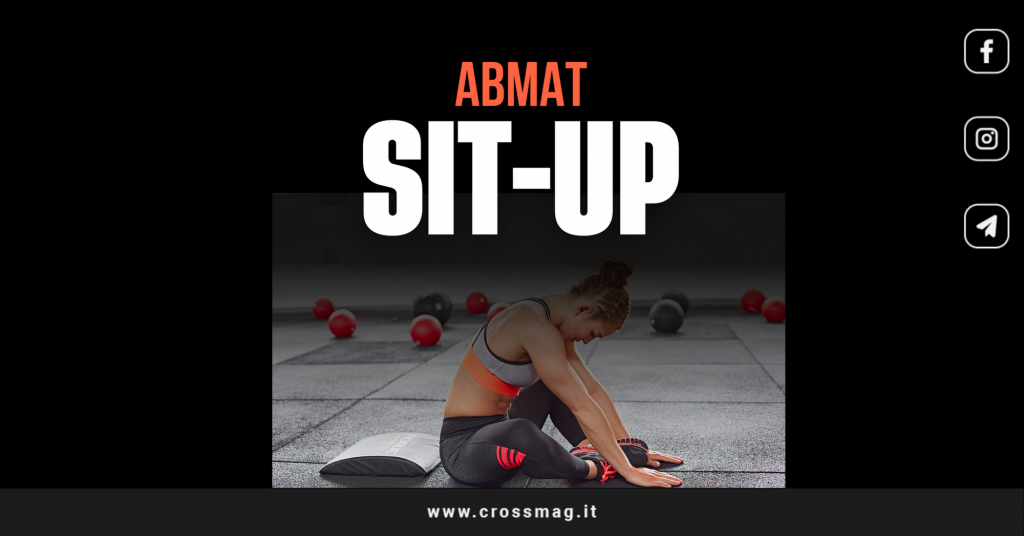Inside the CrossFit® box, between one wod and another, it hides a hero not celebrated enough: the AbMat sit-up. Forget the usual crunches that make you hate the end of the session and get ready to meet your new best ab friend.
This isn't just another exercise to torture your abs; and the key to sculpting them without having to deal with back pain the next day.
Thanks to the AbMat, that little tool that seems to have come out of a pillow shop rather than a gym, you can say goodbye to the monotony of sit-ups, ready to challenge any WOD that comes your way.
Index
What muscles are involved?
When you perform this skill, you use more muscles than you can imagine! First of all, the protagonists: i rectus abdominis muscles. Yes, the ones famous for the tortoiseshell look we all want. The AbMat sit-up puts them to serious work, pushing them to fully contract with each rep.
But not all. Also train your obliques, that is, those lateral muscles that allow you to turn and bend. And let's not forget the support behind the scenes: the iliopsoas muscle.
This group of muscles, which connects your pelvis to your legs, comes into play to help you in the ascent phase, making AbMat sit-ups an undercover total body exercise.
Finally, we also have the stabilizing muscles of the spine, who work behind the scenes to keep you fit and prevent injuries while you get busy. These muscles, along with the AbMat that supports the natural curvature of your back, ensure that each repetition is as safe as it is effective.
Simply put, when you do AbMat sit-ups, you are orchestrating a concert of muscles that goes far beyond simple abdominal training!
Perfect Execution: Step by Step
Correctly performing the AbMat sit-up begins with the starting position: lying on your back, knees bent and feet on the ground, with the AbMat positioned strategically under your lower back.
This position allows you to keep the spine in a slight extension, optimal for activating the abdominal muscles to the maximum.
1 phase: Inhaling, lower your shoulders towards the floor, fully extending your abdominal muscles. Your arms can be extended at your sides, with your hands touching the floor, ready to give you momentum into the next phase.
2 phase: As you exhale, use your abdominal muscles to lift your shoulders off the ground, bringing your torso towards your knees. The arms, following a natural movement, help to create an inertia that facilitates the ascent.
3 phase: At the height of the exercise, be sure to intensely contract your abs, holding the position for a moment before slowly returning to the starting position.
Variations and progression
Once you've mastered the basic form, it's time to push your training to the next level. Variations and progressions not only break up the monotony but challenge your body in new and exciting ways, building force and resistance.
1. AbMat Sit-ups with Weight
To add some oomph to your exercise, try holding a weight plate or kettlebell against your chest while performing the sit-up. This variation increases resistance, forcing your abdominal muscles to work even harder.
Start with a light weight and increase as you gain strength and confidence.
2. Butterfly AbMat Sit-ups
This variation changes the position of the legs to target the muscles a little differently. Sit with the soles of your feet together and your knees open outward, in a butterfly position.
From here, perform the sit-up as usual. This pose can help reduce stress on your hips and increase core activation.
3. AbMat Sit-up with Medicine Ball
Similar to weighted sit-ups, but here you will use a medicine ball. You can hold the ball with your arms extended overhead as you raise and lower yourself, adding an element of overhead resistance that further challenges your abs and core stability.
4. Russian Twist with AbMat
After completing a sit-up, remain seated with your knees bent and your feet off the ground. Holding a weight or medicine ball, rotate your torso and weight from side to side. This is an excellent variation to integrate intense work on the obliques.
Progression
The key to continued progress lies in gradually increasing the intensity and variety. Start by integrating these variations once or twice a week into your training program, then as you get stronger, you can increase the frequency, weight used, or number of repetitions and sets.
** progression must always be guided by correct technique and movement control to avoid injuries and maximize benefits.
Remember: Every AbMat sit-up you complete is one step closer to achieving those results you've always wanted.
It's not just about building stronger muscles or getting that coveted shot."six pack“; it's about improving your overall health, your athletic performance, and feeling the best you can, in and out of the CrossFit® box.
We have activated a lot of discounts on Amazon: from 30 to 70% on all sports categories! Find everything on our dedicated channel ????
SUBSCRIBE HERE TO THE TELEGRAM CHANNEL

